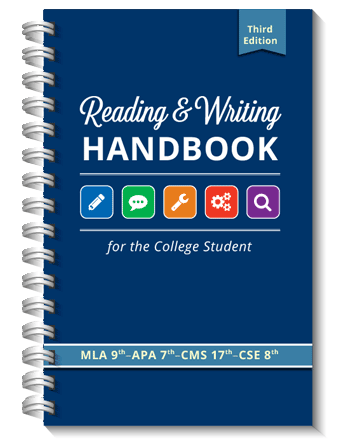
Reading & Writing Handbook for the College Student, 3rd Edition
By Hawkes Learning
Students
Buy PrintOverview
Hawkes Learning's Reading & Writing Handbook for the College Student is a pocket-sized resource containing writing, research, grammar, and style tips. Students can use the handbook as they develop, revise, and edit their writing. This user-friendly resource offers sample writings with annotations, exercises with relatable content for today's diverse college students, and comprehensive yet concise information students can easily navigate without feeling overwhelmed.
As a lifetime learning resource, this example-heavy handbook serves students in all disciplines during and beyond their college years.
- Critical reading and thinking tips
- Comprehensive grammar sections
- Detailed research guidelines, including MLA 9th edition updates and APA, CMS, and CSE formatting
- Writing strategies across curriculums
- Exercises to prompt student application
- Easy-to-use index
New Edition Highlights: Part 5: Research now includes the MLA 9th edition updates that were released in April 2021.
Products
Formats: eBook, Handbook
| Product | ISBN |
|---|---|
| eBook | 978-1-64277-522-8 |
| Handbook | 978-1-64277-521-1 |
Student Resources
Part 1
Part 2
Part 3
Part 4
Part 5
Sample Papers
Table of Contents
- Part 1: Reading & Writing
- 1: Thinking Critically
- a. Critical Reading Process
- b. Determining the Purpose of a Text
- c. Determining the Audience of a Text
- 2: The Writing Process
- a. Pre-writing
- b. Drafting
- c. Revising
- d. Editing
- e. Reflecting
- 3: Common Essay Components
- a. Introductions
- b. Thesis and Purpose Statements
- c. Effective Body Paragraphs
- d. Conclusions
- e. Sample Essay and Organizer
- 4: Organizational Patterns
- a. Cause and Effect
- b. Chronological
- c. Compare and Contrast
- d. Order of Importance
- e. Spatial
- f. Topical
- 5: Writing Across the Curriculum
- a. Similarities & Differences in Writing Assignments
- b. English, Literature, and Language Studies
- c. Business Courses
- d. History
- e. Psychology
- f. Lab Sciences
- g. Engineering and Technology
- 1: Thinking Critically
- Part 2: Effective Sentences
- 6: Combining Word Groups
- a. Coordination
- b. Subordination
- c. Parallelism
- 7: Agreement
- a. Subject-Verb Agreement
- b. Pronoun-Antecedent Agreement
- 8: Modifiers
- a. Using Modifiers
- b. Misplaced and Dangling Modifiers
- 9: Word Choice
- a. Clarity and Conciseness
- b. Vague vs. Vivid Words
- c. Choosing Correct Words
- d. Inclusive Language
- e. Commonly Misused Words
- 10: Shifts in Tense and Person
- a. Consistency in Tense
- b. Consistency in Person
- 6: Combining Word Groups
- Part 3: Grammar Basics
- 11: Parts of Speech
- a. Nouns
- b. Pronouns
- c. Verbs
- d. Adjectives
- e. Adverbs
- f. Prepositions
- g. Conjunctions
- h. Interjections
- 12: Components of a Complete Sentence
- a. Capital Letters and Punctuation Marks
- b. Subjects and Verbs
- c. Complete Thoughts
- 11: Parts of Speech
- Part 4: Punctuation & Mechanics
- 13: Punctuation
- a. Commas
- b. Unnecessary CommasColons
- c. Semicolons
- d. Apostrophes
- e. Quotation Marks
- f. Parentheses
- g. Brackets
- h. Hyphens
- i. Ellipses
- j. Dashes
- 14: Spelling
- a. Common Spelling Rules
- b. Commonly Confused Words
- 13: Punctuation
- Part 5: Research
- 15: The Research Process
- a. Making a Research Plan
- b. Identifying Types of Sources
- c. Finding Sources
- d. Evaluating Source Credibility
- e. Organizing Research
- 16: Research Writing
- a. Narrowing Your Research
- b. Avoiding Plagiarism
- c. Integrating Sources into Your Writing
- 17: MLA
- a. Formatting the Document
- b. Citing the Document Sources
- c. MLA Sample
- 18: APA
- a. Formatting the Document
- b. Citing the Document Sources
- c. APA Sample
- 19: CMS
- a. Formatting the Document
- b. Citing the Document Sources
- c. CMS Sample
- 20: CSE
- a. Formatting the Document
- b. Citing the Document Sources
- c. CSE Sample
- 15: The Research Process
Students.
Purchase Print